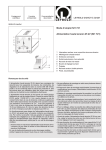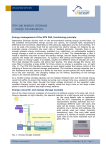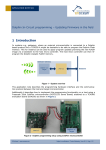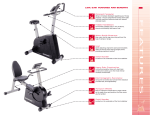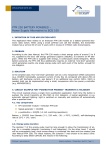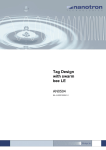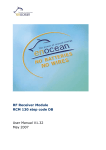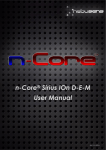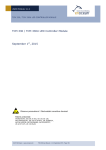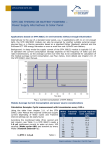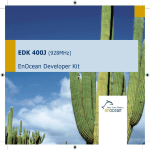Download ECS 300/310 Solar Panel - Design Considerations
Transcript
APPLICATION NOTE 207 ECS 300/310 Solar Panel Design Considerations Solar Panel Design Basics One of the most common energy harvesters today is the solar cell. Solar radiation represents the largest energy resource of the terrestrial ecosystem. The discovery of the photovoltaic effect opened entirely new perspectives on the use of solar light for electricity generation. Unfortunately only about 0.1 to 0.2 % of the sunlight level is available indoors (Fig. 1). Important factors for the right solar panel choice are the specific light source and application energy requirements. Fig. 1 Fig. 2 EnOcean offers an indoor solar panel family ECS 300/310 (EnOcean Converter Solar, in two dimensions: ECS 300 small and ECS 310 medium) optimized for its typical applications. This appnote is a short introduction to indoor use case of solar panels as energy harvesters for typical EnOcean applications. For more details regarding typical indoor light sources and levels as well as measurement recommendations, consult EnOcean AN 201 and especially AN 406. Solar cell efficiency depends on matching between solar cell technology (cell spectral sensitivity Fig. 2) and source radiation spectrum, Fig. 3. Technologically there are two major solar cell types: for outdoor and indoor applications: Crystalline silicon solar cells, also called “for outdoor”, reach best efficiency under outdoor sunlight (peak sensitivity at 800 nm). Fig. 3 Amorphous (thin film) silicon cells, also called “for indoor”, with peak spectral sensitivity at 550 nm similar to the human eye one are actually “specialized” for poor daylight especially indoor light (Fig. 4, output voltage comparison). While conventional crystalline solar cells are about two times more efficient by optimum day light conditions (outdoors), amorphous cells beat them by far at poor indoor light levels and win on the 24-hour energy cycle because they can also efficient use poor artificial light and early morning or evening light. Also because of larger bandgap, amorphous silicon solar cells typically have higher open-circuit voltages, up to 0.8 V/cell. Fig. 4 © EnOcean | www.enocean.com Subject to modifications | Christian Bach | Sep. 2015 | Page 1/ 3 APPLICATION NOTE 207 ECS 300/310 Solar Panel - Design Considerations Solar cells work as light-dependent current generators. While their (open-circuit) output voltage depends only relatively slightly on illumination level over decades, their (shortcircuit) current varies directly proportional to light intensity and solar cell area (Fig. 5). The delivered power is however not quite linear (slightly reduced due to its voltage dependence and internal peripheral leakage currents). These effects become more considerable the smaller the single area cell and lower the light intensity. Brightness is the term that describes how intense a light source is perceived by the human eye and is measured in lux (lx). Fig. 5 As a rough, conservative estimation, indoors and for small area amorphous solar panels (a few cm2) an operating current in the range 10 µA/cm2 @200 lx (FL) can be considered. This value can be roughly linearly extrapolated using a de-rating factor for lower illumination and/or smaller area. That corresponds e.g. to 4.5 µA/cm2 @100 lx. Another extrapolation approach (area x brightness) is shown in Fig. 6 Fig. 6 Additionally, amorphous cells deliver indoors nominal power densities of around 4 µW/cm2 @200 lx or < 2 µW/cm2 @100 lx (i.e. about 4.5 µA x 0.35 V). For best performance the solar panel output voltage should be near the required application operating voltage. The amount of solar panel output voltage mainly depends on the number of serial connected cells (Fig. 7) while the maxFig. 7 imal delivered current capacity is limited by the poorest single cell in the chain (bottleneck!) Means a single shadowed cell in the chain can cause a total failure. Partially shaded cells lead correspondingly to output current decrease. Make sure that in worst cases (i.e. poor light or full sunlight) the delivered output voltage / current remains within the specifications of the powered electronics (e.g. provide appropiate limitation). General Recommendations: Do not forget that these are only rough estimations depending on many variables. First carefully check the specific environmental conditions (e.g. typical use case), define worst case application requirements and add an additional reserve of +20% by the solar panel dimensioning. Make sure that the full solar cell active area is light exposed i.e. especially the peripheral ones are not obstructed by the device case (cover) design. Verify your assumptions by measuring the embedded, real solar panel performance in worst case. Generally consider 25 lx as a lowest brightness limit for designing ambient light powered devices. Below this limit solar cell efficiency drops dramatically. © EnOcean | www.enocean.com Subject to modifications | Christian Bach | Sep. 2015 | Page 2/ 3 APPLICATION NOTE 207 ECS 300/310 Solar Panel - Design Considerations Calculation Example: An EnOcean STM 300 based room sensor should transmit environment data every 100 seconds. The ambient brightness is 100 lx continuously. What dimensions are needed for its solar panel? Current requirement: STM 300 current consumption can be determined from the STM 300 user manual (§ 3.11, see also AN 209). This is about 160 µC (= 160 µAs) for each transmission (including an external sensor circuit and external storage capacitor leakage current). By one wake-up and transmission every 100 seconds a storage capacitor recharge current of > 1.6 µA during the next 100 seconds is needed for the next transmission (1.6 µA x 100 s = 160 µAs). A 1 cm2 single solar cell delivers an operational current of about 4.5 µA @100 lx (at < 2 µW, see considerations above), therefore half of 1 cm2/cell will be enough to deliver 2 µA @0.35 V. Voltage requirement: STM 300 needs a supply voltage between > 2.6 V (@start-up) and 5 V. Therefore at 100 lx eight single cells (0.35 V @100 lx) serially connected are needed. These two conditions (voltage and current requirements @100 lx) give the minimal solar panel area needed for the required application: eight cells x 0.5 cm2 = 4 cm2. An amorphous silicon solar panel, consisting of eight single solar cells connected serial, with an overall area of 4 cm2 is therefore needed. EnOcean’s smallest ECS 300 solar panel, with the dimensions 3.5 x 1.28 cm (= 4 cm2) consisting of eight serial amorphous cells, would fulfill these requirements (see data sheet for more details). For applications that need more energy like e.g. bidirectional room controllers (Smart Acknowledge, see AN 501) larger solar panels like ECS 310 (eight serial cells, 5 x 2 cm = 10 cm2) are required. For application examples requiring even larger solar panels also consult AN 311 (autarkic motion sensors with EnOcean). Note: The indoor solar panels ECS 300/310 can deliver under sunlight an open-circuit voltage (unloaded) > 6 V. To limit the STM 300400 input supply voltage below 5 V by accidentally longer direct sunlight exposure, its VDD and VDDLIM terminals must be connected together, see STM 300/400 user manuals, respectively appropriate Dolphin (V4) Core Descriptions. By the way, longer exposure of “indoor” amorphous silicon cells in direct sunlight (i.e. hundreds of hours > 10,000 lx) leads to gradual degradation of their efficiency by up to -25%, due to the so called Staebler-Wronski effect (light induced degradation processes). Conversely, at such light levels (actually hundred times higher vs. typical indoor levels) the delivered power will be still more than enough in this case too. Disclaimer The information provided in this document describes typical features of the EnOcean radio system and should not be misunderstood as specified operating characteristics. No liability is assumed for errors and / or omissions. We reserve the right to make changes without prior notice. For the latest documentation visit the EnOcean website at www.enocean.com. © EnOcean | www.enocean.com Subject to modifications | Christian Bach | Sep. 2015 | Page 3/ 3



